As an automobile owner, regular maintenance is crucial to ensure your vehicle’s smooth operation and longevity. Among the various routine tasks, changing the engine oil ranks high on the list.
It’s a straightforward procedure that helps keep your engine running smoothly by lubricating its intricate parts. However, one particular issue that can arise during an oil change is a stripped oil drain plug.
This seemingly insignificant component plays a vital role in sealing the oil pan, but it can lead to a whole array of problems when it becomes stripped. You should generally be able to easily thread an oil drain plug in and out.
This plug is not a structural fastener but rather a fluid retention plug. Although, you may find that it is awkward trying to get an oil drain plug started under a car when you feel resistance.
This may just be a piece of crud, and the plug will free up in a few turns. The only problem is it does not free up, and now it’s tight and nowhere near seated.
Or equally bad, the plug turns freely but does not seat. There is now a problem. Looking at how to repair a cross-threaded oil drain plug will help you determine the cause of the problem.
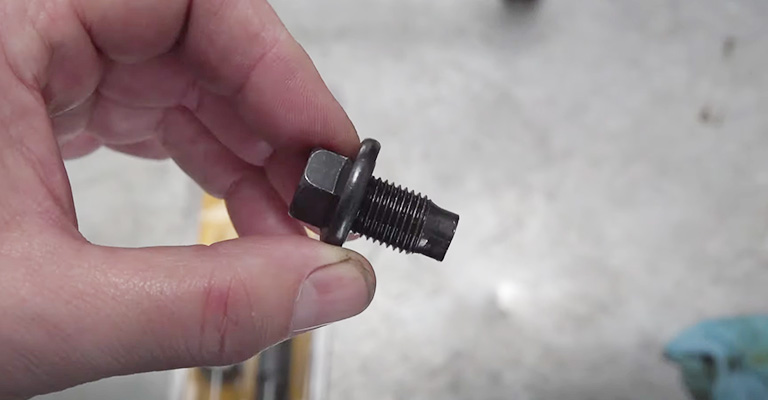
Why Is the Oil Drain Plug Stripped and Stuck?
You can strip the bolt and make removing the oil pan drain plug difficult if you over-tighten it. You may need to replace the oil pan and drain plug in some cases.
The Wrong Tools Were Used
You can also round or strip the bolt when you use the wrong tools to remove or install the bolt, such as using an undersized socket or tightening the bolt without a torque wrench.
The Oil Pan Plug Was Overtightened and Stripped
The oil pan drain plug can strip if you over-tighten it. It can happen, for example, if you tighten the bolt in the wrong direction when you intend to loosen it. Ensuring the oil pan bolt is tightened and loosened correctly will prevent it from stripping.
How To Fix A Stripped Oil Pan Drain Plug?

Simply replacing the plug is the easiest way to repair stripped oil drain plugs.
The cost of replacing an oil drain plug is relatively low, so it is an inexpensive way of guarding against oil leaks. You can repair screw threads, but the low price of a new drain plug is not worth gambling with your engine’s life.
How To Fix A Stripped Oil Drain Plug Hole?
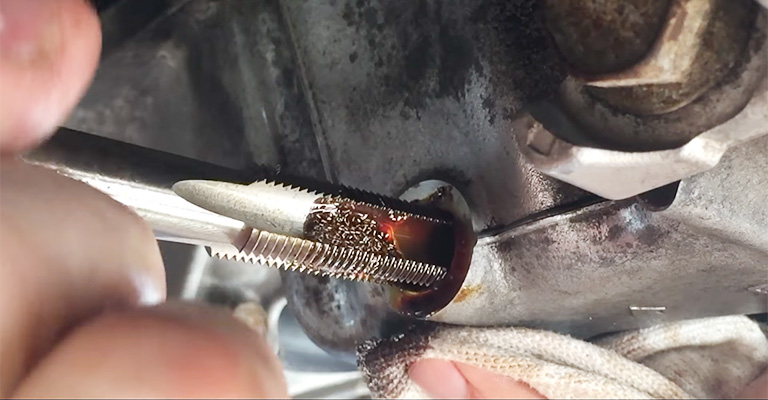
To fix stripped oil drain plugs, you must first not panic. Stop turning it immediately when you notice the oil drain plug won’t tighten. Try to reverse the drain plug out of the hole using your hand.
You can gently pry the drain plug from the pan with a flat-tip screwdriver blade inserted behind the bolt head if the plug does not back out.
Rotate the drain plug slowly to catch the remaining threads on the drain hole. Pull the plug out. Generally, replacing the drain plug once it is out is best. You have a few options to address the stripped oil drain plug hole.
You can install a thread repair kit to renew the threads on drains. Oil drain plugs can also be used to piggyback on oversized drain plugs.
In addition, you can drill the drain hole and tap it for a more giant drain plug, but you must remove the oil pan from the vehicle so that metal shavings are contained during this process.
How To Fix Cross-Threaded Oil Drain Plug?
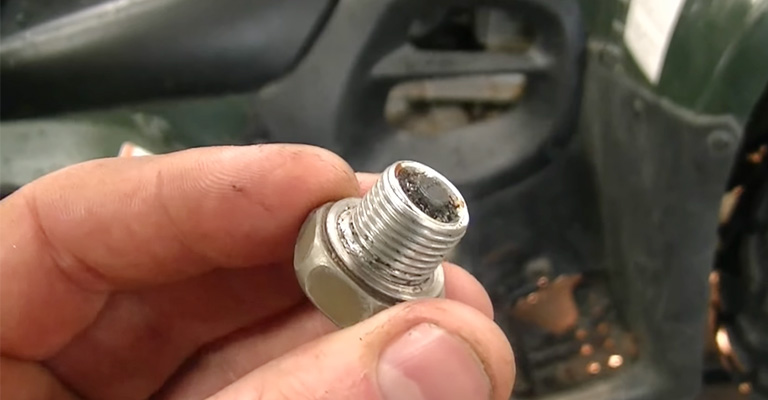
A cross-threaded oil drain plug starts tightening up before it is seated against the pan’s drain hole. The first sign of resistance means you shouldn’t tighten the plug anymore and should back it out.
After removing the oil drain plug, you must repair the threads in the oil drain plug hole using a thread restoration tool. The tool is usually available as a kit with several different thread sizes.
You can select a repair tool based on the thread size of your oil drain plug. Using the repair tool, apply lubricant and turn it by hand slowly while carefully threading it into the oil drain plug hole. A thread repair tool will be used to repair the threads while they are being repaired.
Do not allow the repair tool to pass through the oil pan drain plug hole thoroughly. Stay within the threaded area. For verification, by hand, thread on a new oil pan drain plug (the old one may have been damaged).
How to Properly Install an Oil Drain Plug Bolt?
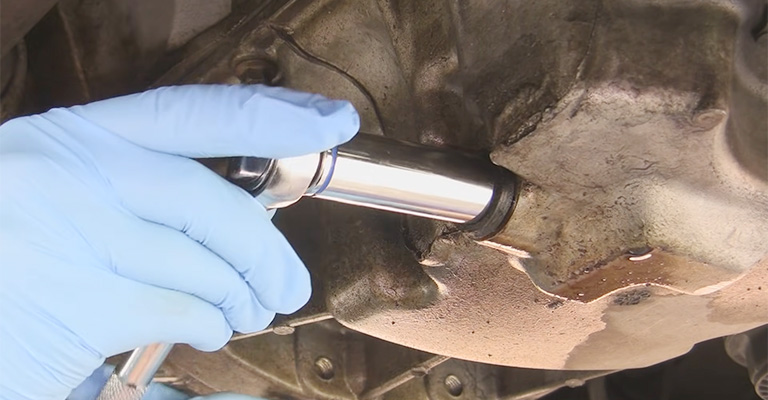
To remove the drain plug, use the appropriate tool, such as a socket or wrench.
Loosen the bolt counterclockwise while rotating the wrench clockwise to avoid overtightening it and stripping the drain plug.
Ensure the threads are in good condition and the plug has been removed correctly. There will be a need to replace the drain plug if they are.
If the gasket is worn, inspect it for tears or wear and replace the plug. Whenever there is a metal gasket on the oil pan plug, it needs to be replaced.
Turn the oil pan plug clockwise, not overtightening, and torque the drain pan bolt to the manufacturer’s specifications. The torque wrench will click once the bolt has been tightened correctly.
How to Use an Oil Drain Plug Repair Kit?
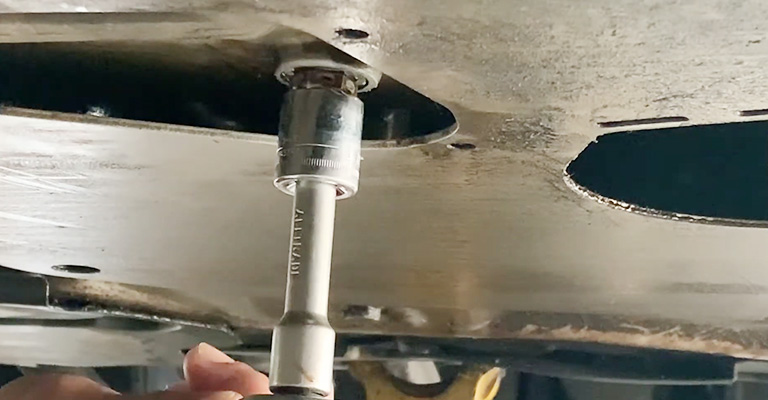
Using an oil drain plug repair kit requires the following steps.
1. Remove Damaged Threads
A reaming bit is included with many oil drain plug repair kits, which removes any preexisting threads. This way, a new drain plug can be installed on the renewed surface.
2. Tap New Threads
Following this, a specially sized tap will be carefully threaded into the oil pan’s drain hole. An oversized drain plug can grab onto the threads created by this process.
A tap of this type is typically rotated several times in a clockwise direction, followed by 1-2 rotations in the opposite direction.
As the tap passes through the drain hole of the oil pan, this process will be repeated until the water from the tap reaches the bottom of the oil pan.
3. Inspect Threads
After tapping new threads into your oil pan’s drain hole, scrutinize them to ensure the threads are in good condition. Ensure that all threads are cut evenly without excess metal shavings.
4. Flush Out Oil Pan
Whenever your oil pan’s drain hole needs to be retaped, it’s a good idea to flush a 12 quart of oil through the engine before replacing the drain plug. This method prevents the vast majority of metal shavings from getting into your engine’s oil.
5. Install Oversized Drain Plug
Thread a new drain plug into the newly rethreaded drain hole on the oil pan. If this plug is tightened for the first time, take care to identify any abnormalities.
According to the instructions contained in your repair kit, you should torque the drain plug itself. To ensure the drain plug seals evenly, ensure the sealing washer is seated evenly around the drain hole’s perimeter after torquing the plug.
6. Refill Oil And Check For Leaks
You should check for leaks after refilling your engine’s crankcase with fresh oil to validate the integrity of your repair. Once again, if no leaks are found, start your engine and check for them again.
Afterwards, drive your vehicle for a short distance again to ensure you have completed this inspection. After a short test drive, you shouldn’t expect any further issues if your oil pan and drain plug are still dry.
Preventing Stripped Drain Plug Threads
While you cannot always avoid experiencing drain plug damage left behind by a previous owner, several precautions can be taken to prevent such damage.
Following these key procedural points, you can almost prevent stripping a drain plug.
Using the right-sized wrench or socket is imperative during every oil change. In this way, the hexagonal head of a drain plug is reduced to an almost nonexistent degree of rounding off.
It is often possible to find the correct drain plug size for a specific vehicle by browsing the Internet or by consulting the service manual for that specific vehicle.
In addition, it is recommended that the drain plug be tightened following the appropriate torque specifications. By following this guide, you will reduce the possibility of damaging your engine’s oil pan threads or drain plug.
In addition to preventing over-torquing, it’s equally important to ensure the drain plug isn’t left loose in any way.
The Bottom Line
The only alternative is a replacement of the oil pan if all else fails. It may just involve removing a few oil pan bolts, or you may have to completely remove your engine, depending on how your vehicle was engineered.
Some vehicles have plastic oil pans that can’t be repaired using common methods. The universal oil drain plug may also work if none of these methods work.
No matter what the thread conditions are, these kinds of plugs seal the oil drain hole. Avoid the temptation to use sealants since they may leak back into the oil pan and clog the oil pump pickup.
In the future, you will still have to perform routine maintenance on your engine, so make sure it can still be drained.

Leave a Reply